Language
- English
- Español
- Français
- Italiano
- Português
- Deutsch
- Nederlands
Currency
- AUD Australian Dollar
- CAD Canadian Dollar
- EUR Euro
- GBP Pound Sterling
- USD US Dollar
- ZAR Rand

A pack of African wild dogs (also known as ‘painted wolves' or ‘painted hunting dogs') is one of the most thrilling sights to see on safari. Extremely rare but with a growing population, wild dogs in Africa are estimated to have a population of around 6600 in 2023, with conservation efforts across the content aiding in their resurgence. These canids embody all the characteristics we think of in predators: keen intelligence, fine cooperation, excellent hearing, great strength, great vision and sheer speed. The excitement when a guide announces that wild dogs have been spotted in the vicinity is palpable!
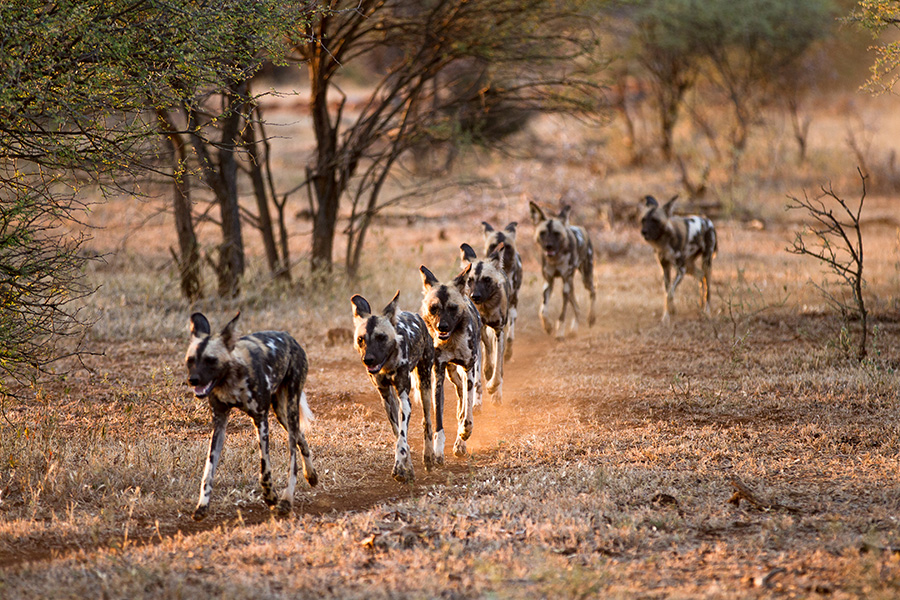
Safari season in Africa runs anywhere from March to October, with different regions experiencing their driest periods at different times. From March to June, sightings of African wild dogs will be highest around the sites that they select to den. For up to 12 weeks after birth, packs will use these dens, leaving their pups there until they are a few months old. The sites are usually away from waterfront areas that have higher predator populations, with packs being especially careful to avoid areas with high lion activity. Instead, they opt to locate their sources of food and water within the ranges of their carefully selected homes.
From July to October, wild dogs will gather more closely to water sources as these are the driest months in Southern African regions. Because of this, lucky African wild dog safari goers during this time will often see packs near and around bodies of water, taking a sip to stay hydrated. In East African regions such as Kenya and Tanzania, the dry seasons are from June to October.
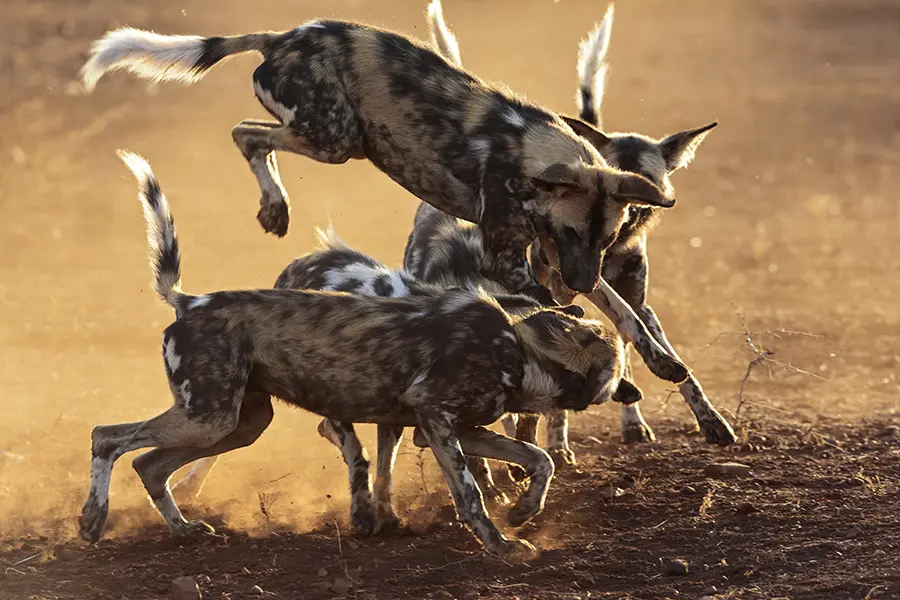
Nothing beats watching wild dogs on a hunt (they aren't really wolves – this is just a different name for them). Individual dogs communicate by ‘sneezing', indicating whether or not they are hungry, and whether they should go on a hunt. Once consensus is reached, the pack will silently approach their prey such as a Thomson's gazelle, a warthog, a zebra or a wildebeest, carefully surrounding it to block off escape routes. When the animal realises that it is being stalked, the chase commences! And what a chase it is: wild dogs can reportedly reach speeds of nearly 70 kilometres / 44 miles an hour for up to sixty minutes at a time.
The wild dogs communicate all the time during the hunt, telling each other where the quarry is. Because they are quite small and slightly built, they cannot rely on the brute strength that lions and leopards have to break their prey's neck or slash the jugular – wild dogs will bite their mark's legs and nose, wearing it down until the entire pack is able to overwhelm the animal and tear it apart. Once again, unlike their bigger feline cousins, wild dogs eat immediately. While leopards will often stash prey in a tree and lions will take their time, wild dogs devour their meal right away so that they aren't vulnerable to opportunistic hyenas, jackals, lions and leopards coming along and chasing them off for their hard-won meat.
In the strict hierarchy, pups younger than a year eat first. They have expended plenty of energy on the hunt and are the most vulnerable to being killed so they must keep their strength up. Once they've finished eating, the pack will move on immediately. The smell of blood will draw other carnivores, and wild dogs do not want to have to deal with lions, in particular.
Of all predators, wild dogs are easiest to see on the chase because – like cheetahs – they hunt during the day. This is a boon to safari-goers. Have your camera ready: they move fast and will duck under vegetation if necessary. In fact, it's sometimes best just to put your camera down and live in the moment. Pack members fan out and it's hard to focus on all of them at the same time. Just sit and enjoy the privilege of seeing these incredible animals putting their astounding qualities to the test. Researchers suggest that at least eighty percent of chases end in a kill – the highest of all predators.
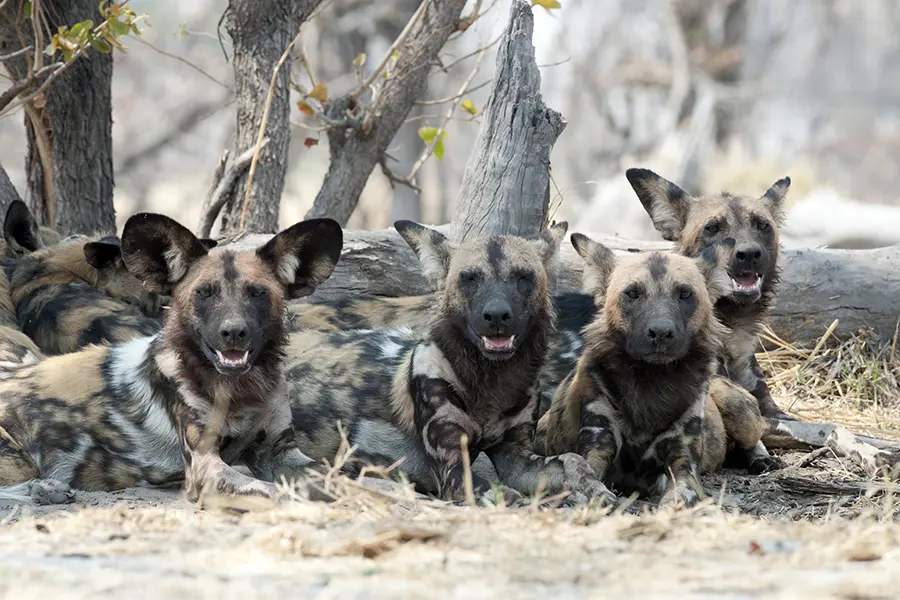
Often, what springs to mind when one watches a pack resting is how similar they are to domestic litters and dogs. Puppies will play with sticks, practising their hunting skills. The matriarch and patriarch (unusually, each pack has a dominant male and a dominant female) will keep an eye out and lead the pack in hunting. There is cuddling, playful nibbling, chasing and stretching out.
Pack members are also known to sleep nestled together for safety and warmth. The youngsters especially are very curious and have been known to approach game-drive vehicles, sniffing every inch of the tyres and body. All animals in Africa will rest during the hottest parts of the day – look out under shrubs and trees for the best chance of seeing a pack as their mottled coats camouflage them extremely well. Their gold, white and black fur melds perfectly with dappled sunlight and you need sharp eyes to spot them.
While wild dogs can be spotted across various African regions, the largest known populations thrive in Botswana (Okavango), Tanzania (Nyerere) and Zimbabwe (Hwange). But there are plenty of other top safari destinations where wild dogs are making a resurgence and sightings are good – let's check them out:
A safari in Botswana is renowned as the best place to see African wild dogs, as the country hosts 30% of the world’s remaining population, with an estimated average of 700 individuals. Botswana has all the ingredients for a successful resurgence: a good conservation ethos, excellent habitat preservation and a low-visitor tourism model that keeps animals and environments as unstressed as possible.
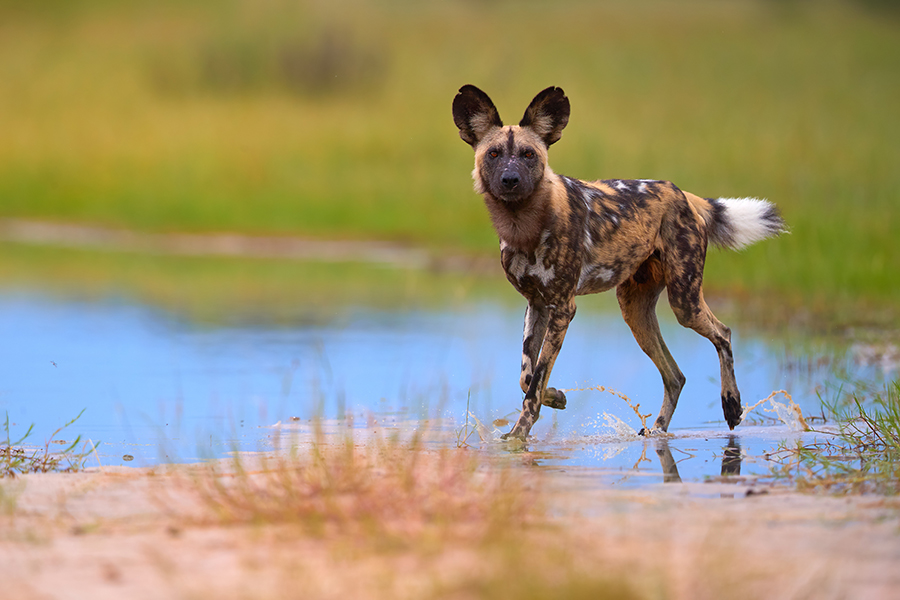
The Linyanti is an area in northern Botswana wedged between the border with Namibia, the Selinda Channel and Savute. The Linyanti Swamp is one of the most productive regions for excellent wildlife sightings.
Where to Stay in the Linyati:
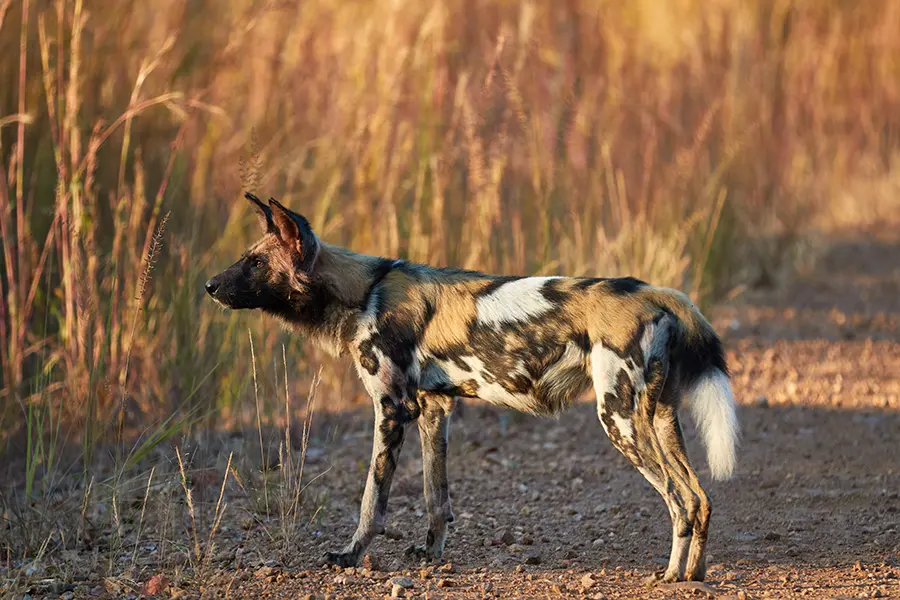
Adjoining Linyanti, Kwando is one of the largest private concessions in all of Botswana, offering guests complete privacy and exclusivity. There are only two lodges here and you have access to a phenomenal 232 000 hectares of boundless land to explore virtually all by yourself. Kwando safari goers also report frequent wild dog sightings.
Where to Stay in Kwando:
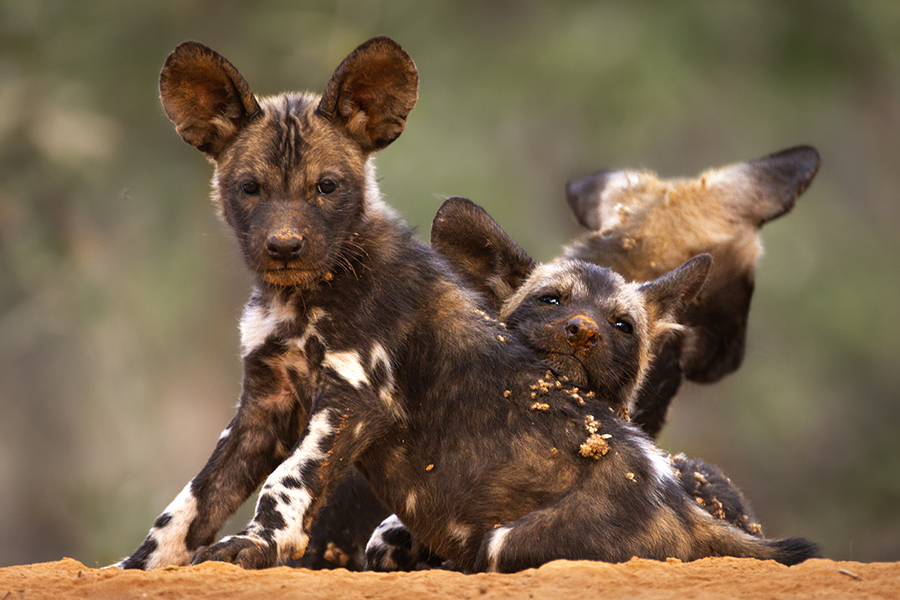
Encompassing a massive swathe of the central and eastern Okavango Delta, Moremi Wildlife Reserve is a classic collection of wetland, fertile floodplains, open grassland and riverine forest. The Khwai Concession is run by the local community and borders the Khwai River and the north-east of Moremi. There is often game along the Khwai river which attracts wild dogs to the area.
Where to Stay in Moremi and Khwai:
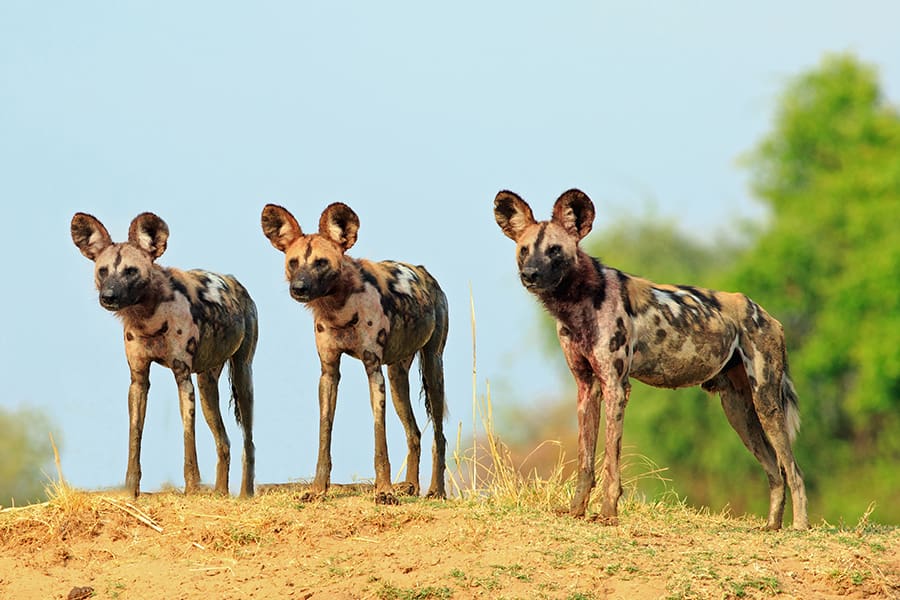
Okavango- the world's biggest inland delta, is made all the more remarkable by the fact that it is found in a country that is more than seventy percent semi-desert. Wild dogs are more likely to be found in ‘drier' camps rather than those that are almost permanently surrounded by water and on Chief's Island. They're fairly nervous about the water, instinctively fearing crocodiles that may be lurking just under the surface of the Okavango's water.
Where to Stay in the Okavango Delta:
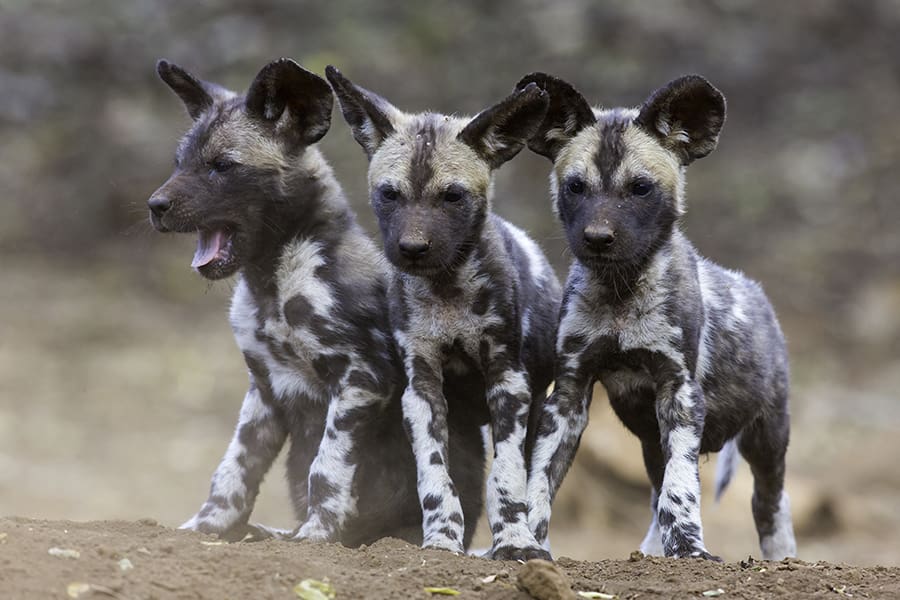
South Luangwa National Park is amongst Zambia’s most-loved safari destinations and for many, this is because it is home to the big five, but it also offers one of the most exceptional chances to witness African Wild Dogs. Efforts such as de-snaring and vaccinations are implemented to protect the wild dogs within the area, with an estimated 350 of them in the Luangwa Valley. The perfect time for visitors to go on walking safaris is between June and October, with guides tracking wild dogs through the wood and grasslands- an exciting experience.
The impala, puku and other prey species in the region attract the dogs and make it a top sighting spot for enthusiasts. Up close and personal game drives and guided walking safaris provide intimate encounters with these fascinating creatures and give you a chance to observe their unique social dynamics in real time.
Where to Stay in South Luangwa:
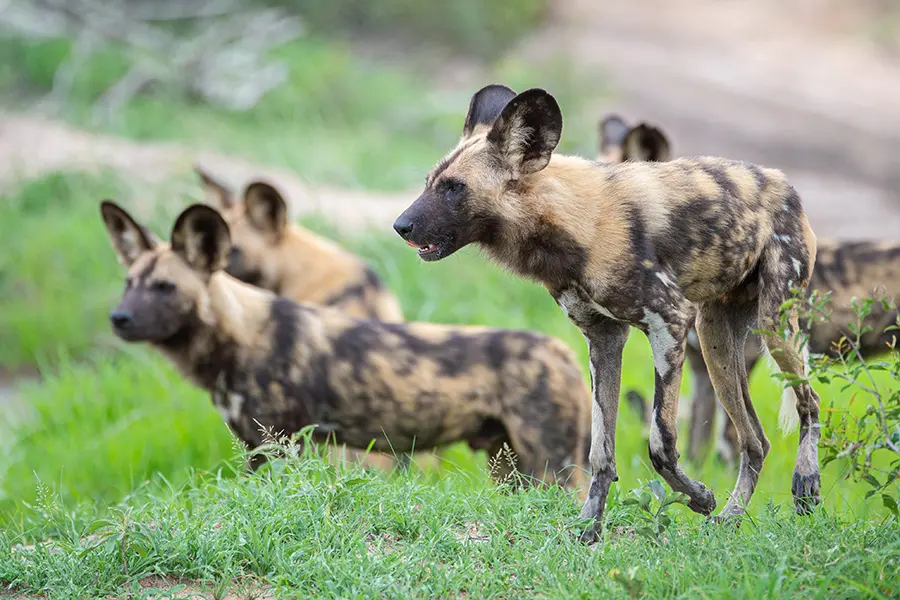
Situated alongside the Zambezi River, the Lower Zambezi National Park, with its decided landscapes, forests, and endless plains is where you'll encounter tracks and hear the distinctive calls of African wild dogs. Visitors here find the wildlife encounters more intimate and personalized because it has fewer tourists. The Lower Zambezi is home to a thriving population of these rare predators, making it a prime destination for witnessing these canines and their charismatic disposition in their natural habitat.
Where to Stay in Lower Zambezi:
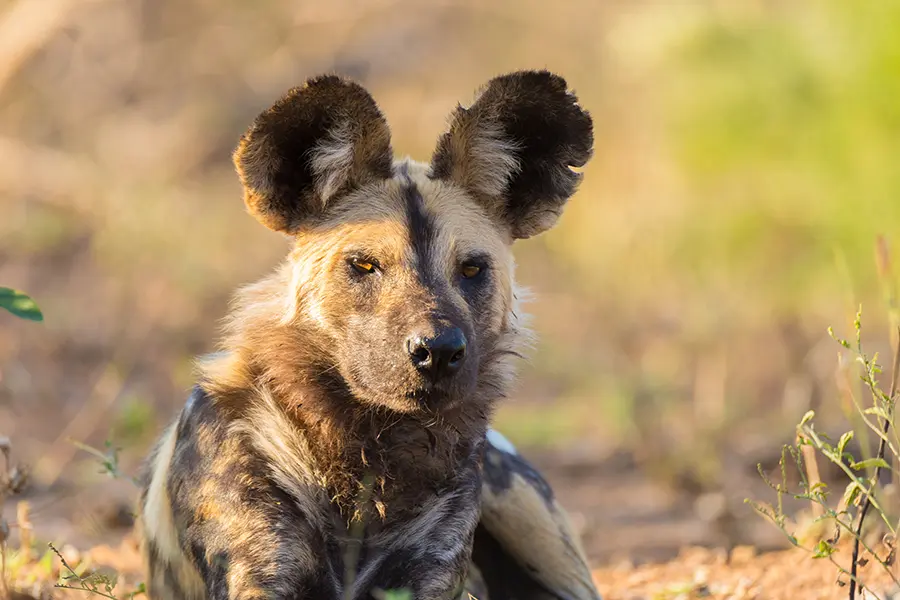
The Greater Kruger area takes in not only the Kruger National Park but also surrounding private reserves like the Sabi Sands, Timbavati, MalaMala and Manyeleti. There are fairly regular sightings of packs throughout the region, which lies to the northeast of South Africa, with around 400 wild dogs in the park.
Where to Stay in Greater Kruger:
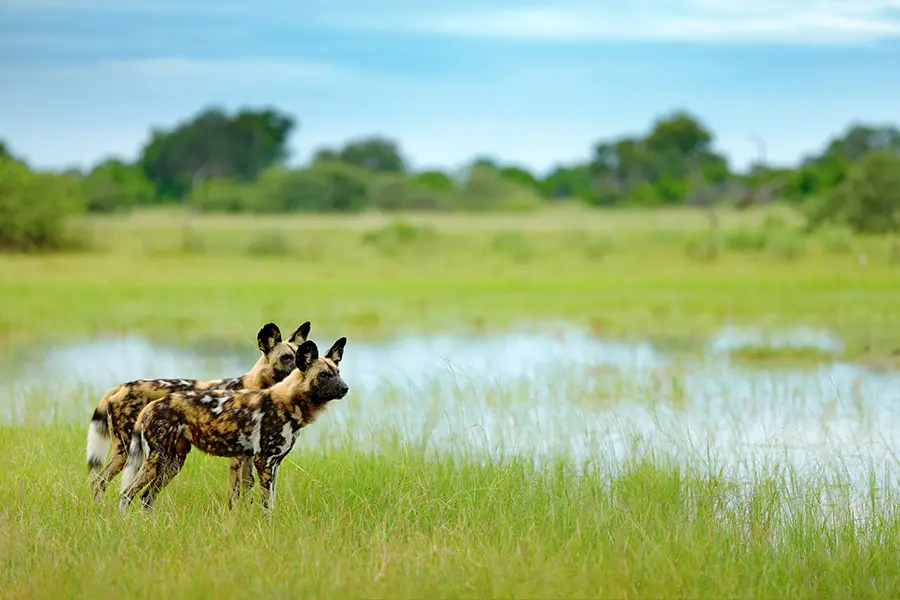
Madikwe Private Game Reserve was a frontrunner in the successful re-introduction of wild dogs to reclaimed farmland. The packs here were previously under threat from disease but the wild dog population now thrives throughout the game reserve with dogs known to be lively and even unflinching around vehicles. An added benefit of Madikwe is that safari goers are able to take advantage of closer off-road viewings as they are not limited to the roads. Additionally, the lack of foliage in winter makes it easier to spot the animals as they can't hide as much. It is important to note though, that as a private game reserve entrance is only permitted by reservation and not to the general public.
The Pilanesberg National Park is situated just on the border of the famed Sun City resort. Renowned for its exceptional Pilanesberg Safari experiences, this park showcases a frequent occurrence of wild dog sightings, although the wild dogs in this area tend to avoid tourist roads.
Where to Stay in Madikwe and Pilanesberg:
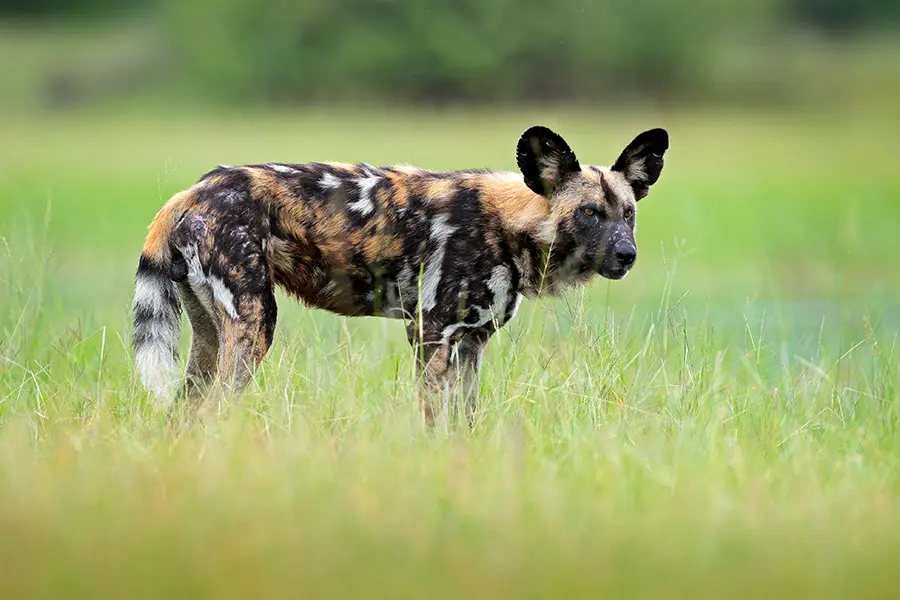
Privately owned, and the biggest game reserve in South Africa, Tswalu is rich in game. Its vastness can make it difficult to know where to spot the wild dogs, but expert guides and trackers have made regular sightings throughout the area possible.
Where to Stay in Tswalu Kalahari:
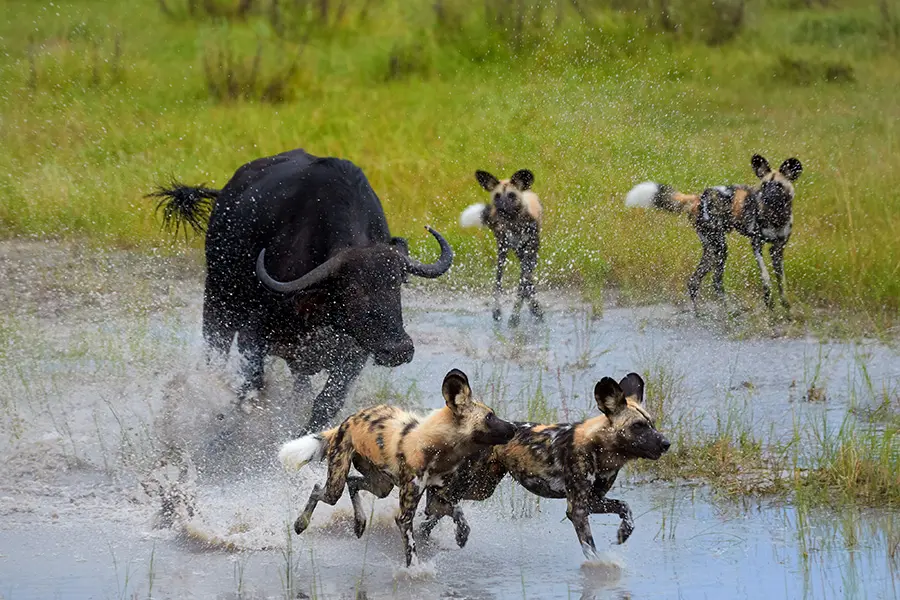
Zimbabwe offers many opportunities to see African wild dogs in action, with the Painted Conservation recording around 700 dogs across the region. Although Zimbabwe's flagship wildlife area is Hwange National Park, a Mana Pools safari, favoured by Zimbabwe Safari enthusiasts, offers abundant encounters with wild dogs. In fact, this is where the BBC's Dynasties wildlife programme was filmed, which features memorable interactions like elephants charging wild dogs that get too close. This pretty park on a stretch along the Zambezi River is good to combine with time at Victoria Falls.
Where to Stay in Mana Pools:
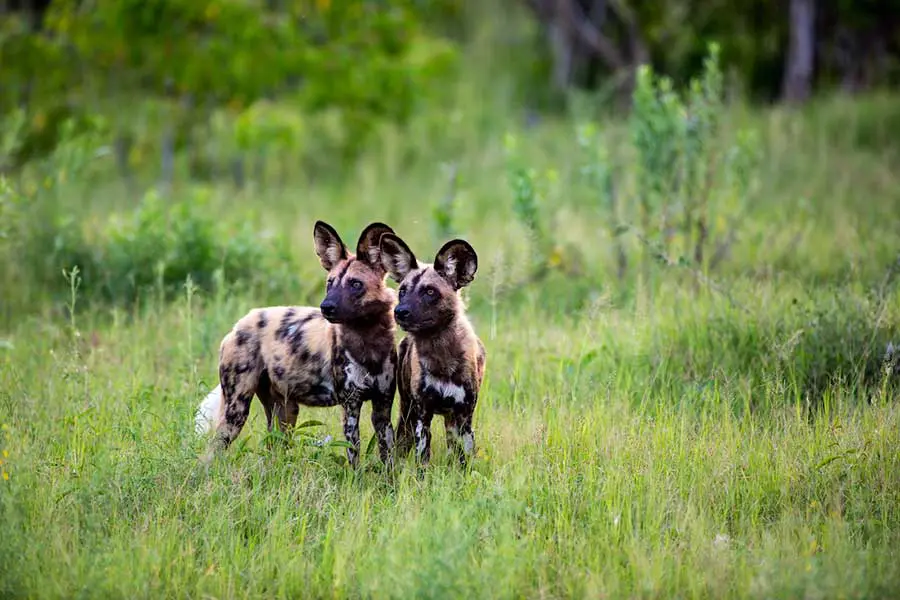
Hwange National Park is Zimbabwe’s largest and premier safari destination for observing African Wild Dogs. Home to approximately 200 wild dogs in over 30 packs, it boasts one of Africa’s highest concentrations of these endangered animals.
The park also hosts the longstanding Painted Dog Conservation Project, dedicated to safeguarding and reintroducing wild dog packs. With diverse landscapes, including savanna grasslands and mopane woods, Hwange offers exceptional wildlife encounters. Besides vehicle-based safaris, visitors can enjoy walking tours along with viewing hides for incredible wildlife sightings.
Where to Stay in Hwange:
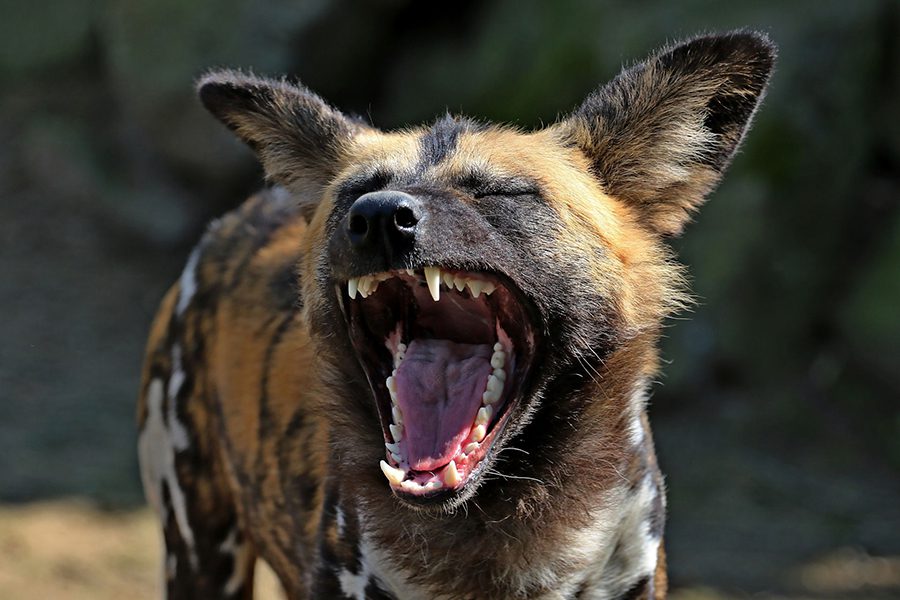
One of the world's biggest conservation areas, Nyerere (previously Selous) offers vast tracts of land for a limited number of travellers to explore. It is also home to around 800 wild dogs, making it perfect for an African wild dog safari. Because it is so big, wildlife has plenty of space to move around but going out on the chase yourself is half the fun of safari! Being a lesser-visited area, Nyerere offers an intimate safari experience.
Where to Stay in Nyerere:
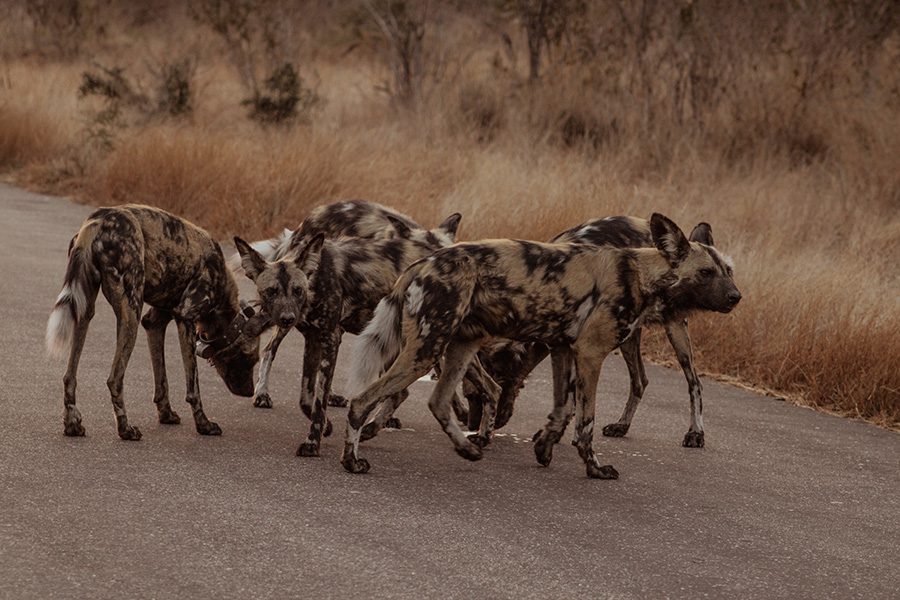
Much more arid and hillier than the Masai Mara, Laikipia and Samburu are two lesser-visited areas of Kenya that pack a massive punch in terms of wildlife viewing. You may be lucky enough to spot wild dogs but also look out for the Samburu Special 5, endemic species found only here (reticulated giraffe, beisa oryx, Somali ostrich, long-necked gerenuk and Grevy's zebra).
Where to Stay in Laikipia and Samburu:
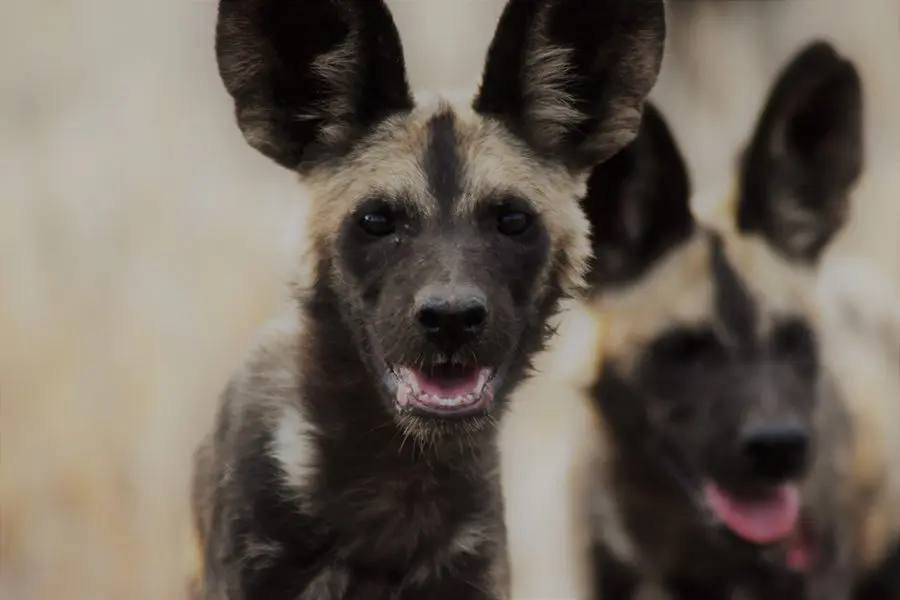
There are many reasons, including those befalling all wildlife across the world such as habitat loss and vulnerability to diseases, specifically rabies and canine distemper. Lions are ruthless in destroying any wild dog puppies they come across and have been known to kill all the pups in a den. In fact, at some point, lion predation was recorded as the highest cause of wild dog mortality amongst free-roaming wild dogs. Because they rely completely on cooperative hunting, a pack with few members has a very low chance of survival against lions and hyenas.
Humans also pose a threat to wild dogs, as farmers sometimes resort to poisoning and shooting them in an effort to safeguard their livestock. In contrast, hyenas generally do not target domestic animals but may prey on livestock if they encounter it.
In addition to natural factors like animal predation and disease, wild dogs in parts of Southern Africa were also hunted to almost extinction by humans who thought that their method of cooperative killing was ‘cruel and unnatural'. A myth existed among early colonial farmers that wild dogs were ‘evil' and packs should be eradicated en masse – one that has fortunately been put firmly to rest.
Today there is thankfully a massive conservation drive to save the remaining wild dogs and packs are slowly resurging. This is important because wild dogs avoid incestuous breeding – if individual numbers grow, then harmful incestuous breeding can hopefully be avoided and the species can thrive.
Help Protect Wild Dogs
| How to Help African Wild Dogs
Help Protect Wild Dogs
Protecting Africa’s Wildlife with Go2Africa and the Endangered Wildlife Trust (EWT) Meet our Positive Impact Partner, Endangered Wildlife Trust (EWT). Our partnership with EWT, a non-profit conservation organization based in South Africa, is a journey into safeguarding Africa’s precious species and ecosystems. Founded in 1973, the organisation is dedicated to preserving threatened wildlife and habitats for the well-being of all. With expanding operations across Southern and East Africa, EWT conducts research, conservation programs, and promotes sustainable natural resource management. Their flagship programme, the Carnivore Conservation Programme (CCP), focuses on saving threatened carnivores, with African wild dogs as their main priority. EWT aims to increase wild dog populations and change human attitudes towards these animals. One of EWT’s essential projects is expanding wild dog habitats, especially in Kruger National Park, where they’ve seen significant success. At Go2Africa, we support EWT by pledging donations to help track and protect wild dogs in Greater Kruger. When you book a Kruger safari with us, you’re not just exploring Africa; you’re actively contributing to wildlife conservation. Join us and EWT in our mission to save African wild dogs and experience a safari that makes a real difference. For more information on the Carnivore Conservation Programme and the Endangered Wildlife Trust efforts to monitor and track African wild dogs, watch our video here. |